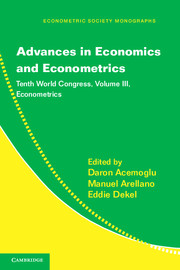Book contents
- Frontmatter
- Contents
- Contributors
- Preface
- I ECONOMETRICS OF INDUSTRIAL ORGANIZATION
- II MACROECONOMETRICS
- III ECONOMETRIC THEORY
- IV EMPIRICAL MICROECONOMICS
- V TIME SERIES AND PANELS
- VI MIRRLEES REVIEW: RETHINKING THE TAX SYSTEM FOR THE TWENTY-FIRST CENTURY
- 14 Empirical Evidence and Earnings Tax Design: Lessons from the Mirrlees Review
- 15 A Review of the Mirrlees Review: Labor Tax Reforms
- 16 The Mirrlees Review and Optimal Labor Income Tax and Transfer Programs
- Name Index
- Miscellaneous Endmatter
14 - Empirical Evidence and Earnings Tax Design: Lessons from the Mirrlees Review
Published online by Cambridge University Press: 05 May 2013
- Frontmatter
- Contents
- Contributors
- Preface
- I ECONOMETRICS OF INDUSTRIAL ORGANIZATION
- II MACROECONOMETRICS
- III ECONOMETRIC THEORY
- IV EMPIRICAL MICROECONOMICS
- V TIME SERIES AND PANELS
- VI MIRRLEES REVIEW: RETHINKING THE TAX SYSTEM FOR THE TWENTY-FIRST CENTURY
- 14 Empirical Evidence and Earnings Tax Design: Lessons from the Mirrlees Review
- 15 A Review of the Mirrlees Review: Labor Tax Reforms
- 16 The Mirrlees Review and Optimal Labor Income Tax and Transfer Programs
- Name Index
- Miscellaneous Endmatter
Summary
How should evidence be used in the study of tax design? What is the appropriate balance between theory and empirics? These questions lay at the heart of the Mirrlees Review. Motivated by the aim to develop a broad set of principles for what makes a “good tax system,” the Review was an attempt to build a base for tax reform from the large body of economic theory and empirical evidence. It was inspired by the Meade Report (1978) with the idea to review tax design from first principles for modern open economies in general and for the United Kingdom in particular. The United Kingdom in the past 30 years would be the working laboratory.
The Review was published in two volumes, Dimensions of Tax Design (Mirrlees et al. 2010), bringing together expert evidence across a wide range of aspects of tax reform, and Tax by Design (Mirrlees et al. 2011), setting out the conclusions and recommendations.
This chapter examines the role of evidence used in the derivation of recommendations for reform. It also examines the linkages between theory and empirical evidence. To keep consistency and coherence in the discussion, the focus here is on the taxation of earnings, although the Review concerned all aspects of the tax system. The discussion is organized loosely under five related headings:
(i) key margins of adjustment
(ii) measurement of effective tax rates
(iii) importance of information and complexity
(iv) evidence on the size of responses
(v) implications from theory for tax design
The main sections of this chapter reflect these five aspects.
- Type
- Chapter
- Information
- Advances in Economics and EconometricsTenth World Congress, pp. 547 - 584Publisher: Cambridge University PressPrint publication year: 2013

